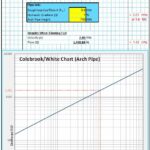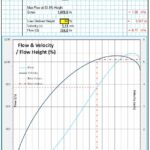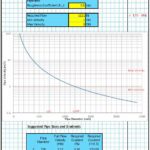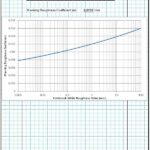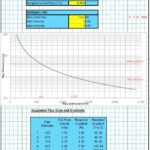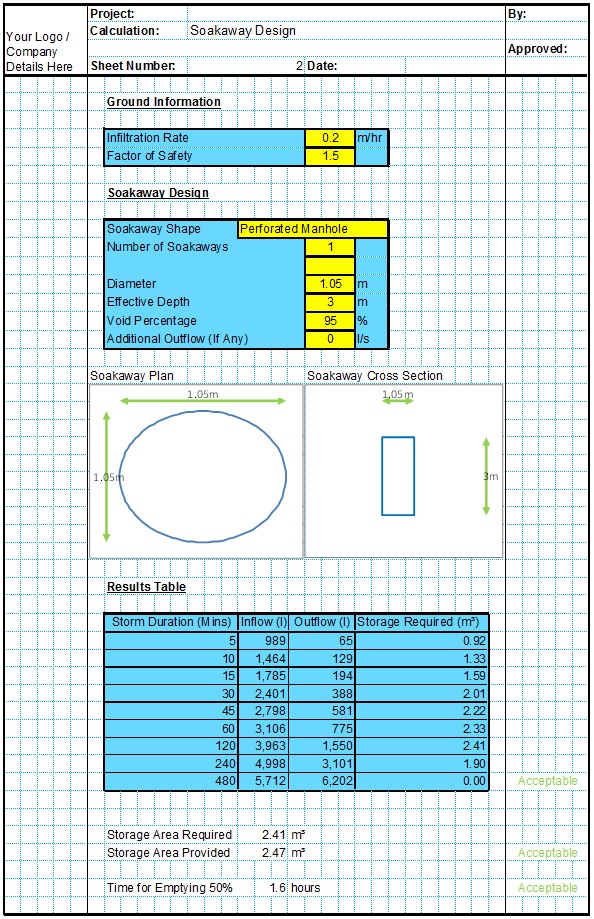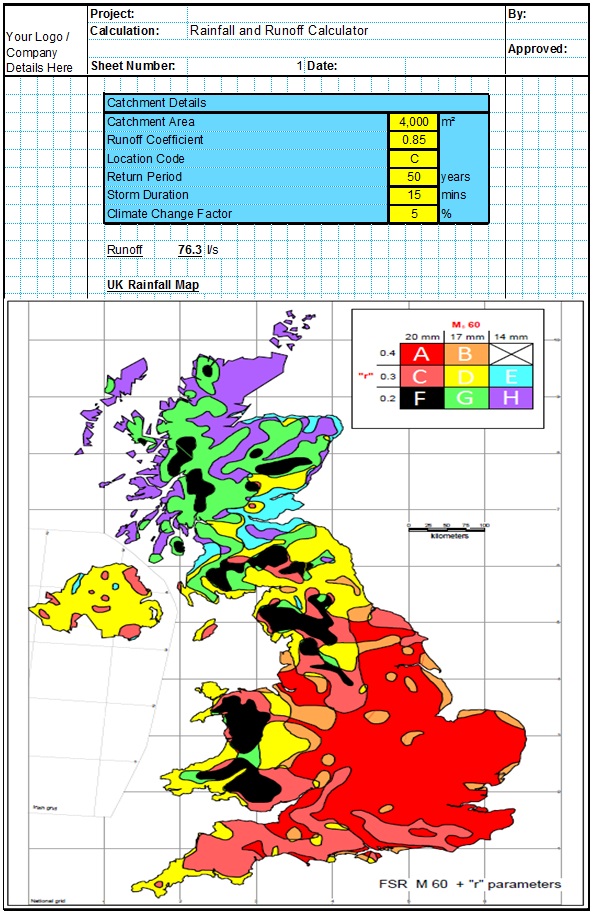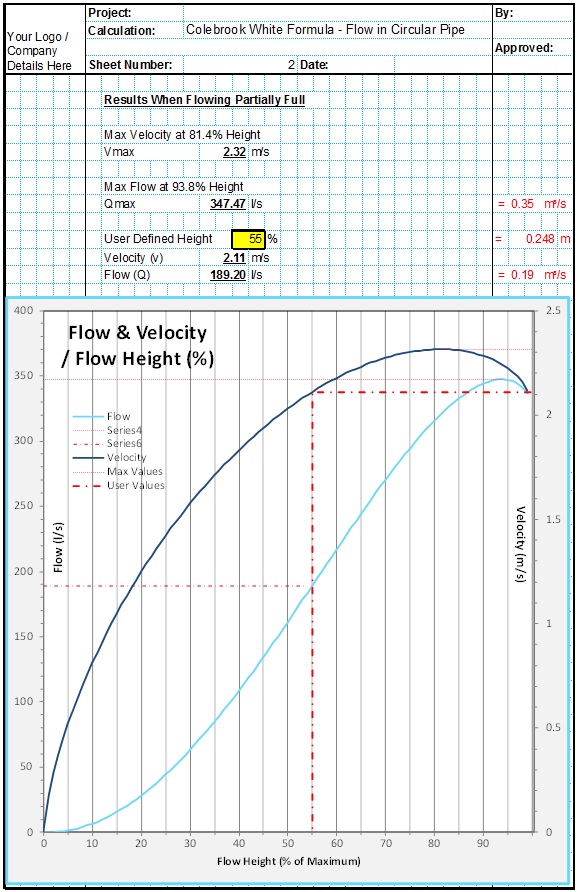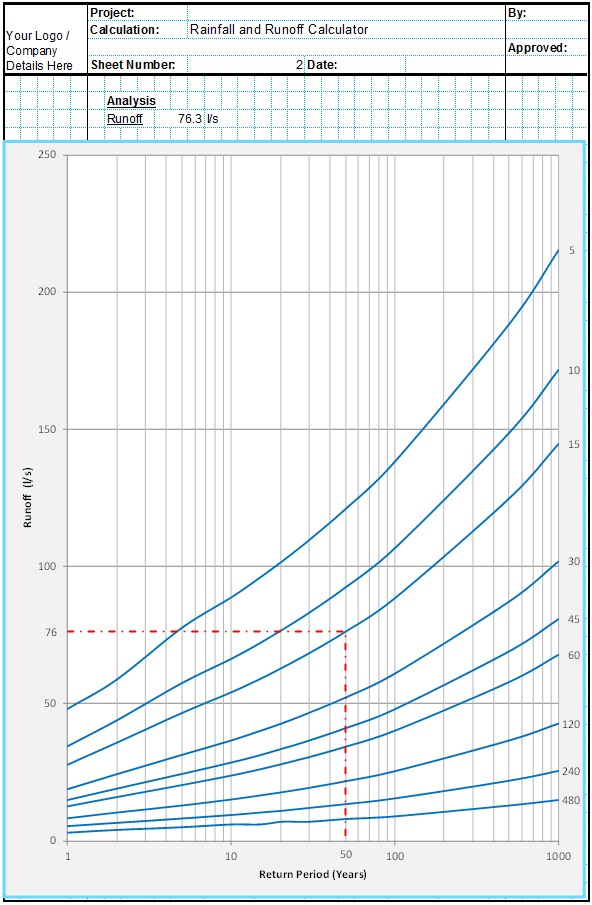The CivilWeb Pipe Flow Calculator spreadsheet is an advanced drainage design and analysis spreadsheet which can calculate the flow rate through a drainage pipe using either the Colebrook-White equation or the Manning Equation. The spreadsheet includes unique design features to make detailed drainage pipe design quicker and easier than ever.
Main Spreadsheet Features
The spreadsheet suite includes two main sheets, one used for designing new drainage pipes and one used for analysis of an existing drainage pipe. The design spreadsheet allows the user to simply specify the required flow , the maximum and minimum velocity and the pipe roughness. The spreadsheet then calculates the standard pipe sizes and gradients which match the required flow rate at an acceptable velocity. The designer can see at a glance all the suitable pipe sizes and gradients which meet the design conditions.
The designer can then input a pipe of any size and gradient for analysis. The spreadsheet calculates the pipes maximum flow and velocity as well as the flow and velocity of the pipe running full. These are then checked against the design conditions. Note that design conditions are usually only compared against the values for the pipe running full. This is generally a convention designed to simplify the calculations but with advanced software such as this spreadsheet the design conditions can easily be checked against the maximum value as well as the pipe full values. The spreadsheet also presents a design graph for this pipe and gradient showing the flow rate and average velocity at any height of flow. This information is essential if the pipe is not designed to run full, velocity and flow rates can easily be determined from the graph at any water height. This unique design sheet enables the user to complete drainage pipe design in seconds, quicker than any other software on the market.
The pipe analysis sheet allows the designer to create bespoke design graphs based on the specific pipe roughness values required. This graph can be used to quickly evaluate the suitability of different pipe sizes and gradients. This sheet also creates a graph showing the flow rate and velocity at different water heights and allows the user to calculate precise values for these parameters at any specified water height level in the pipe. Each of these design spreadsheets includes a Colebrook-White and Manning Equation version.
Additional Calculation Tools Included
Along with the main design spreadsheets for pipe design and analysis, the CivilWeb Pipe Flow Calculator suite includes a number of other useful design tools;
- Non-Circular Cross Section Analysis - A tool is included completing the same analysis but for common non-circular pipe cross sections such as arch, ovoid or elliptical pipes. There is also a calculator tool for analysis of non-standard pipe dimensions using the hydraulic radius and the wetted perimeter for analysis of the pipe cross section. As with the design and analysis spreadsheets, versions are included for both the Colebrook-White Equation and the Manning Formula.
- Kinematic Viscosity of Water Calculator - This tool calculates the kinematic viscosity of water at any temperature. The kinematic viscosity of the water is a required input when using the Colebrook-White equation. Whilst it has only a small impact of the results, the standard values for kinematic viscosity may not be appropriate in conditions of extreme cold or heat.
- Geometric Properties of Pipes Tool - A tool is also included which calculates the geometric properties of a circular pipe at any height of flow. This includes angle of flow, area of flow, width of flow, wetted perimeter and the hydraulic radius.
- Geometric Properties of Pipes with Sedimentation Tool - A similar spreadsheet is also included calculating the above parameters but including a level of sedimentation in the bottom of the pipe. This can be useful when analysing an existing pipe with a degree of sedimentation or for analysing a new pipe where some sedimentation has been allowed for as part of the design conditions.
- Colebrook-White/Manning Roughness Coefficient Converter - This tool estimates an appropriate Manning Roughness value from a known Colebrook-White Roughness Coefficient. This can be useful when converting a pipe designed using the Manning Formula for analysis according to the Colebrook-White Equation or vice versa.
- Rising Mains Roughness Coefficient Calculator - This tool calculates a suitable value for the roughness coefficient for rising mains depending on the velocity of the water in the rising main.
- Joint Eccentricity Roughness Coefficient Calculator - This tool calculates a suitable Colebrook-White Roughness Coefficient allowing for the joint eccentricity when evaluating existing clay pipes.
- Sediment Bed Roughness Coefficient Calculator - This very useful tool calculates a suitable Colebrook-White Roughness Coefficient for a pipe with a user specified sediment bed running at a user specified water height. This compares the equivalent roughness of the sediment bed and pipe walls to calculate a composite value for the whole pipe. This is essential when modelling the hydraulic performance of an existing pipe with a sediment bed or when analysing a new drainage pipe where some sedimentation has been allowed for as part of the design conditions.
- Sediment Quantity Estimator Tool - This useful tool estimates the quantity of sediments which can be expected to enter the drainage system. This is an important input when sedimentation needs to be taken into account when designing a new drainage pipe. Geographical and site specific inputs are used to estimate the likely levels of sedimentation which can then be input into a sedimentation analysis such the below.
- Sedimentation Analysis - This spreadsheet performs a detailed sedimentation analysis in accordance with CIRIA Report R141. This includes analysis of five potential design conditions; sediments transported in suspension with no deposition, sediments transported as bedload with no sediment bed, sediments transported in suspension with a defined sediment bed, sediments transported as bedload with a sediment bed and finally the self-cleansing velocity which allows sediments deposited during low flows to be flushed through the pipe during high flows. Each design condition is then analysed to determine the minimum full flow velocity to achieve each condition. This allows the designer to choose a much more accurate value for the minimum velocity, particularly compared to many standard specifications such as Sewers for Adoption.
Get the full license version now for only £20. This includes;
- Full Pipe Flow Calculator Spreadsheet with all inputs available.
- Free comprehensive 70 page Ultimate User Guide. This includes detailed information and typical values for all the required inputs and an explanation of the design standards and principles used in the spreadsheet.
- More than 20 additional calculation sheets as detailed above including non-circular pipe analysis and detailed sedimentation analysis.
All purchases are covered by our full money back guarantee.
Or why not bundle the CivilWeb Pipe Flow Calculator with our Rainfall Calculator Spreadsheet for only £5 extra?
Download Free Trial Version
To try out a fully functional free trail version of this software, please Click Here or enter your email address below to sign up to our newsletter.

